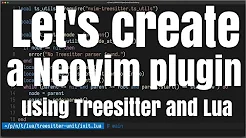A tiny Neovim plugin to deal with treesitter units. A unit is defined as a treesitter node including all its children. It allows you to quickly select, yank, delete or replace language-specific ranges.
For inner selections, the main node under the cursor is selected. For outer selections, the next node is selected.
Requirements: nvim-treesitter including a parser for your language
For vim-plug:
Plug 'David-Kunz/treesitter-unit'
For packer:
use 'David-Kunz/treesitter-unit'
You can select the current treesitter unit
:lua require"treesitter-unit".select(outer?)
This function takes an optional Boolean flag to specify if the outer scope should be selected as well, default false.
For operations like delete, change, ... please see section "Useful mappings".
You can toggle automatic highlighting for the current treesitter unit.
:lua require"treesitter-unit".toggle_highlighting(higroup?)
As an optional parameter you can specify the highlight group, default: "CursorLine".
Alternative: enable_highlighting(higroup?) and disable_highlighting().
For init.vim:
xnoremap iu :lua require"treesitter-unit".select()<CR>
xnoremap au :lua require"treesitter-unit".select(true)<CR>
onoremap iu :<c-u>lua require"treesitter-unit".select()<CR>
onoremap au :<c-u>lua require"treesitter-unit".select(true)<CR>
For init.lua:
vim.api.nvim_set_keymap('x', 'iu', ':lua require"treesitter-unit".select()<CR>', {noremap=true})
vim.api.nvim_set_keymap('x', 'au', ':lua require"treesitter-unit".select(true)<CR>', {noremap=true})
vim.api.nvim_set_keymap('o', 'iu', ':<c-u>lua require"treesitter-unit".select()<CR>', {noremap=true})
vim.api.nvim_set_keymap('o', 'au', ':<c-u>lua require"treesitter-unit".select(true)<CR>', {noremap=true})
Examples:
viuto select the inner unitcauto change the outer unit
- nvim-treesitter-textobjects for more fine-granular control
- nvim-treesitter for incremental selection
- nvim-ts-hint-textobject

